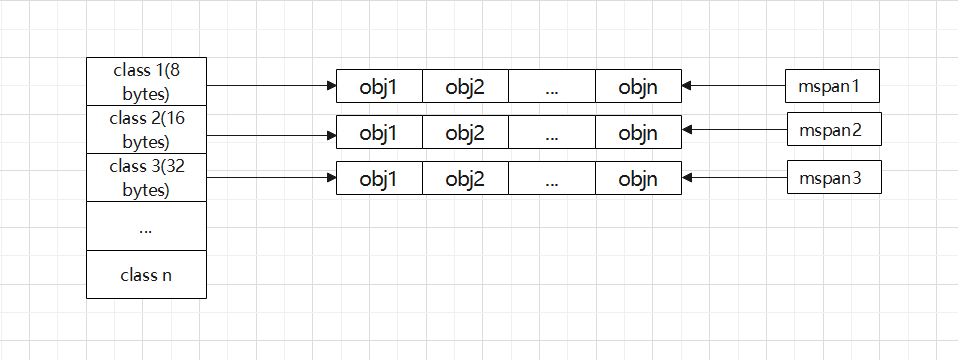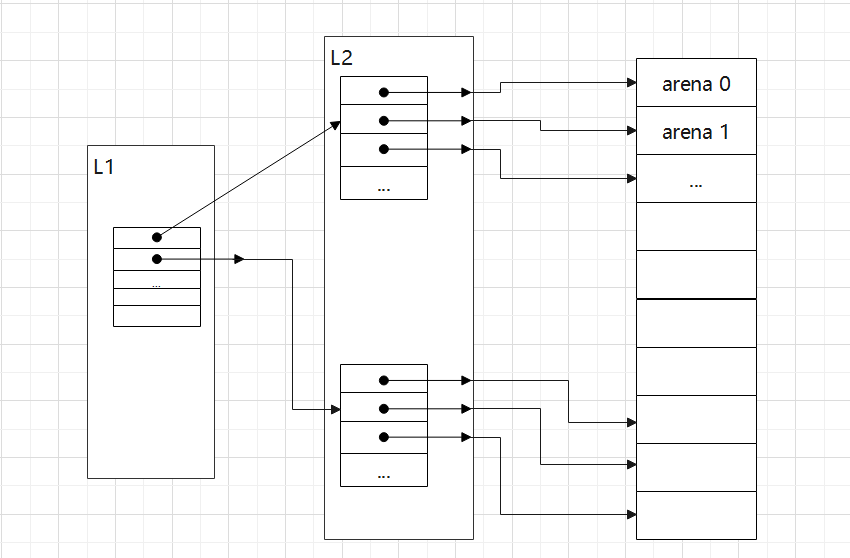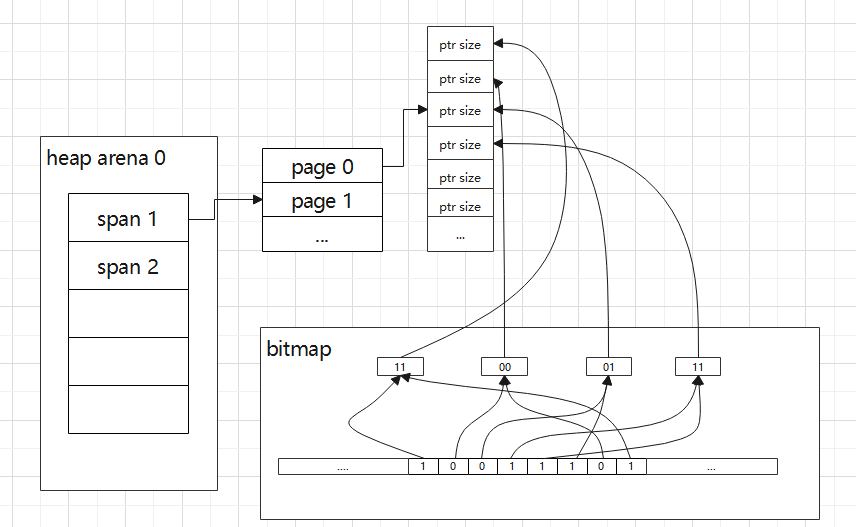Golang runtime内存管理机制
工作中遇到一个golang项目内存占用非常多,于是根据pprof工具反馈的热点做了优化,优化后通过pprof能看出来改善明显,原来的热点几乎不见了,但是top上显示的RSS内存占用却没什么变化,于是用runtime.ReadMemStats想看下runtime自己统计的内存占用相关信息,这个函数返回的结构体MemStats:
type MemStats struct {
// Alloc is bytes of allocated heap objects.
//
// This is the same as HeapAlloc (see below).
Alloc uint64
// TotalAlloc is cumulative bytes allocated for heap objects.
//
// TotalAlloc increases as heap objects are allocated, but
// unlike Alloc and HeapAlloc, it does not decrease when
// objects are freed.
TotalAlloc uint64
// Sys is the total bytes of memory obtained from the OS.
//
// Sys is the sum of the XSys fields below. Sys measures the
// virtual address space reserved by the Go runtime for the
// heap, stacks, and other internal data structures. It's
// likely that not all of the virtual address space is backed
// by physical memory at any given moment, though in general
// it all was at some point.
Sys uint64
// Lookups is the number of pointer lookups performed by the
// runtime.
//
// This is primarily useful for debugging runtime internals.
Lookups uint64
// Mallocs is the cumulative count of heap objects allocated.
// The number of live objects is Mallocs - Frees.
Mallocs uint64
// Frees is the cumulative count of heap objects freed.
Frees uint64
// HeapAlloc is bytes of allocated heap objects.
//
// "Allocated" heap objects include all reachable objects, as
// well as unreachable objects that the garbage collector has
// not yet freed. Specifically, HeapAlloc increases as heap
// objects are allocated and decreases as the heap is swept
// and unreachable objects are freed. Sweeping occurs
// incrementally between GC cycles, so these two processes
// occur simultaneously, and as a result HeapAlloc tends to
// change smoothly (in contrast with the sawtooth that is
// typical of stop-the-world garbage collectors).
HeapAlloc uint64
// HeapSys is bytes of heap memory obtained from the OS.
//
// HeapSys measures the amount of virtual address space
// reserved for the heap. This includes virtual address space
// that has been reserved but not yet used, which consumes no
// physical memory, but tends to be small, as well as virtual
// address space for which the physical memory has been
// returned to the OS after it became unused (see HeapReleased
// for a measure of the latter).
//
// HeapSys estimates the largest size the heap has had.
HeapSys uint64
// HeapIdle is bytes in idle (unused) spans.
//
// Idle spans have no objects in them. These spans could be
// (and may already have been) returned to the OS, or they can
// be reused for heap allocations, or they can be reused as
// stack memory.
//
// HeapIdle minus HeapReleased estimates the amount of memory
// that could be returned to the OS, but is being retained by
// the runtime so it can grow the heap without requesting more
// memory from the OS. If this difference is significantly
// larger than the heap size, it indicates there was a recent
// transient spike in live heap size.
HeapIdle uint64
// HeapInuse is bytes in in-use spans.
//
// In-use spans have at least one object in them. These spans
// can only be used for other objects of roughly the same
// size.
//
// HeapInuse minus HeapAlloc estimates the amount of memory
// that has been dedicated to particular size classes, but is
// not currently being used. This is an upper bound on
// fragmentation, but in general this memory can be reused
// efficiently.
HeapInuse uint64
// HeapReleased is bytes of physical memory returned to the OS.
//
// This counts heap memory from idle spans that was returned
// to the OS and has not yet been reacquired for the heap.
HeapReleased uint64
// HeapObjects is the number of allocated heap objects.
//
// Like HeapAlloc, this increases as objects are allocated and
// decreases as the heap is swept and unreachable objects are
// freed.
HeapObjects uint64
// StackInuse is bytes in stack spans.
//
// In-use stack spans have at least one stack in them. These
// spans can only be used for other stacks of the same size.
//
// There is no StackIdle because unused stack spans are
// returned to the heap (and hence counted toward HeapIdle).
StackInuse uint64
// StackSys is bytes of stack memory obtained from the OS.
//
// StackSys is StackInuse, plus any memory obtained directly
// from the OS for OS thread stacks (which should be minimal).
StackSys uint64
// MSpanInuse is bytes of allocated mspan structures.
MSpanInuse uint64
// MSpanSys is bytes of memory obtained from the OS for mspan
// structures.
MSpanSys uint64
// MCacheInuse is bytes of allocated mcache structures.
MCacheInuse uint64
// MCacheSys is bytes of memory obtained from the OS for
// mcache structures.
MCacheSys uint64
// BuckHashSys is bytes of memory in profiling bucket hash tables.
BuckHashSys uint64
// GCSys is bytes of memory in garbage collection metadata.
GCSys uint64 // Go 1.2
// OtherSys is bytes of memory in miscellaneous off-heap
// runtime allocations.
OtherSys uint64 // Go 1.2
// NextGC is the target heap size of the next GC cycle.
//
// The garbage collector's goal is to keep HeapAlloc ≤ NextGC.
// At the end of each GC cycle, the target for the next cycle
// is computed based on the amount of reachable data and the
// value of GOGC.
NextGC uint64
// LastGC is the time the last garbage collection finished, as
// nanoseconds since 1970 (the UNIX epoch).
LastGC uint64
// PauseTotalNs is the cumulative nanoseconds in GC
// stop-the-world pauses since the program started.
//
// During a stop-the-world pause, all goroutines are paused
// and only the garbage collector can run.
PauseTotalNs uint64
// PauseNs is a circular buffer of recent GC stop-the-world
// pause times in nanoseconds.
//
// The most recent pause is at PauseNs[(NumGC+255)%256]. In
// general, PauseNs[N%256] records the time paused in the most
// recent N%256th GC cycle. There may be multiple pauses per
// GC cycle; this is the sum of all pauses during a cycle.
PauseNs [256]uint64
// PauseEnd is a circular buffer of recent GC pause end times,
// as nanoseconds since 1970 (the UNIX epoch).
//
// This buffer is filled the same way as PauseNs. There may be
// multiple pauses per GC cycle; this records the end of the
// last pause in a cycle.
PauseEnd [256]uint64 // Go 1.4
// NumGC is the number of completed GC cycles.
NumGC uint32
// NumForcedGC is the number of GC cycles that were forced by
// the application calling the GC function.
NumForcedGC uint32 // Go 1.8
// GCCPUFraction is the fraction of this program's available
// CPU time used by the GC since the program started.
//
// GCCPUFraction is expressed as a number between 0 and 1,
// where 0 means GC has consumed none of this program's CPU. A
// program's available CPU time is defined as the integral of
// GOMAXPROCS since the program started. That is, if
// GOMAXPROCS is 2 and a program has been running for 10
// seconds, its "available CPU" is 20 seconds. GCCPUFraction
// does not include CPU time used for write barrier activity.
//
// This is the same as the fraction of CPU reported by
// GODEBUG=gctrace=1.
GCCPUFraction float64 // Go 1.5
// EnableGC indicates that GC is enabled. It is always true,
// even if GOGC=off.
EnableGC bool
// DebugGC is currently unused.
DebugGC bool
// BySize reports per-size class allocation statistics.
//
// BySize[N] gives statistics for allocations of size S where
// BySize[N-1].Size < S ≤ BySize[N].Size.
//
// This does not report allocations larger than BySize[60].Size.
BySize [61]struct {
// Size is the maximum byte size of an object in this
// size class.
Size uint32
// Mallocs is the cumulative count of heap objects
// allocated in this size class. The cumulative bytes
// of allocation is Size*Mallocs. The number of live
// objects in this size class is Mallocs - Frees.
Mallocs uint64
// Frees is the cumulative count of heap objects freed
// in this size class.
Frees uint64
}
}
尽管文档有比较详细的描述,但是有些字段理解起来依然很模糊,需要结合Golang runtime的内存管理机制来理解,本文就以此契机来深入了解下Golang1.13的内存管理。
几个重要的数据结构
mspan
Golang的内存管理是基于google tcmalloc的实现,会把不同size划分成一些size class,内存分配是根据需要的size找到最小能满足的size class,而mspan简单来的说是数页(虚拟页,大小是8KB)内存空间,根据指定的size class拆分成可用的大小相等的obj等待分配。 所有size class:
// class bytes/obj bytes/span objects tail waste max waste
// 1 8 8192 1024 0 87.50%
// 2 16 8192 512 0 43.75%
// 3 32 8192 256 0 46.88%
// 4 48 8192 170 32 31.52%
// 5 64 8192 128 0 23.44%
// 6 80 8192 102 32 19.07%
// 7 96 8192 85 32 15.95%
// 8 112 8192 73 16 13.56%
// 9 128 8192 64 0 11.72%
// 10 144 8192 56 128 11.82%
// 11 160 8192 51 32 9.73%
// 12 176 8192 46 96 9.59%
// 13 192 8192 42 128 9.25%
// 14 208 8192 39 80 8.12%
// 15 224 8192 36 128 8.15%
// 16 240 8192 34 32 6.62%
// 17 256 8192 32 0 5.86%
// 18 288 8192 28 128 12.16%
// 19 320 8192 25 192 11.80%
// 20 352 8192 23 96 9.88%
// 21 384 8192 21 128 9.51%
// 22 416 8192 19 288 10.71%
// 23 448 8192 18 128 8.37%
// 24 480 8192 17 32 6.82%
// 25 512 8192 16 0 6.05%
// 26 576 8192 14 128 12.33%
// 27 640 8192 12 512 15.48%
// 28 704 8192 11 448 13.93%
// 29 768 8192 10 512 13.94%
// 30 896 8192 9 128 15.52%
// 31 1024 8192 8 0 12.40%
// 32 1152 8192 7 128 12.41%
// 33 1280 8192 6 512 15.55%
// 34 1408 16384 11 896 14.00%
// 35 1536 8192 5 512 14.00%
// 36 1792 16384 9 256 15.57%
// 37 2048 8192 4 0 12.45%
// 38 2304 16384 7 256 12.46%
// 39 2688 8192 3 128 15.59%
// 40 3072 24576 8 0 12.47%
// 41 3200 16384 5 384 6.22%
// 42 3456 24576 7 384 8.83%
// 43 4096 8192 2 0 15.60%
// 44 4864 24576 5 256 16.65%
// 45 5376 16384 3 256 10.92%
// 46 6144 24576 4 0 12.48%
// 47 6528 32768 5 128 6.23%
// 48 6784 40960 6 256 4.36%
// 49 6912 49152 7 768 3.37%
// 50 8192 8192 1 0 15.61%
// 51 9472 57344 6 512 14.28%
// 52 9728 49152 5 512 3.64%
// 53 10240 40960 4 0 4.99%
// 54 10880 32768 3 128 6.24%
// 55 12288 24576 2 0 11.45%
// 56 13568 40960 3 256 9.99%
// 57 14336 57344 4 0 5.35%
// 58 16384 16384 1 0 12.49%
// 59 18432 73728 4 0 11.11%
// 60 19072 57344 3 128 3.57%
// 61 20480 40960 2 0 6.87%
// 62 21760 65536 3 256 6.25%
// 63 24576 24576 1 0 11.45%
// 64 27264 81920 3 128 10.00%
// 65 28672 57344 2 0 4.91%
// 66 32768 32768 1 0 12.50%
size class 对应mspan:

实际上mspan不仅是按照size class来分类,还会按照obj是否noscan来分类,size class + noscan作为key,叫做span class。这样做是为了提高gc效率,因为noscan的mspan可以不用扫描。
func makeSpanClass(sizeclass uint8, noscan bool) spanClass {
return spanClass(sizeclass<<1) | spanClass(bool2int(noscan))
}
mspan.allocBits是一个位图,标记是否某个obj已分配,每个obj index对应一位,1表示已分配,0表示未分配,真正分配的时候从mspan.freeindex开始遍历,直到找到第一个未分配的obj返回,其中为了提高效率做了些优化,比如mspan.allocCache是最近使用的allocBits的8字节cache:

mspan中其他几个常用字段的意思:
allocCount:已经分配了多少个obj;
nelems:总共有多少个obj;
startAddr:mspan中管理的内存的起始地址,用于计算obj的地址;
npages:mspan中总共管理多少页内存;
mcache
mcache可以认为是每个P(Go的虚拟核心)私有的内存cache,不与其他P共享,因此访问不需要加锁,效率最高。它包含:
- alloc: span class到mspan的映射map;
- tiny, tinyoffset: 微小内存(<=16字节)管理;
在mcache中的分配流程(可见malloc.go:mallocgc的实现)按照分配的size会有不同的逻辑:
- 微小内存分配:size<=16字节,且分配的对象不包含指针(gc时不需要扫描)会根据当前tinyoffset判定tiny中是否有足够内存分配,如果有则直接切走返回,如果没有则去size class为16字节的mspan中分配一个空闲obj,从obj中切走指定size,如果还有剩余则cache到tiny中以备下次使用;
- 小内存分配:size<=32KB,先根据size找到对应的size class,再通过alloc映射表找到对应的mspan,从mspan中分配出一个空闲的obj,如果这个mspan不存在任何空闲的obj,会往下层请求分配一个可用的mspan(这个后文会描述)放到mcache中替换老的mspan,然后用新的mspan分配一个空闲obj;
- 大内存分配:直接从下层分配一个全新的mspan,取第一个obj返回,注意这个mspan并不缓存到mcache中;
我们必须关注的一些细节是:
- mallocgc函数返回的内存往往会比请求的内存要多,这个一个是因为分配的内存地址需要对齐,一个是因为mspan中的obj都是等大小的内存块。
mcentral
mcentral管理同类mspan(span class相同),在多个P之间共享,对其操作需要加锁。mcentral结构主要由两个mspan list构成:
- nonempty: 存放还有可分配obj的mspan;
- empty:存放已经被cache到各个P的mcache中的mspan,也就是不能再分配的mspan;
在上一节mcache分配内存的步骤2中我们讲到,当某个mspan没有任何空闲obj可分配,则会去下层请求,这个请求其实转到了对应的mcentral的cacheSpan函数,这个函数的流程大致是从nonempty摘除一个mspan,放到empty中去,并返回给对应mcache让其使用,还有部分逻辑是在一边触发gc的sweep操作释放obj,因为即便在empty list中的span可能还未sweep,说不定sweep后也能空出可用的span。
我们必须关注的细节是:mcentral管理的内存,对应的是small size classes,也就是上节中的第二种情况。
mheap
mheap属于内存分配的最底层,主要有三个字段:
- central:所有不同span class到对应mcentra的l映射map;
- free:是一个Treap数据结构,所有free span都存放在此,每一个Treap node都存放一个free span;
- arenas:heapArena map,实际是数组,使用arenaIndex做索引来访问;
heap arena
Go把堆空间划分成一块块等大小的arena,叫做heap arena,所有span都是在arena上分配,在64bit系统上这个大小是64MB,每个heap arena的起始地址都是和size对齐的,并且分配器尽量保证arena之间内存连续。数据结构heapArena对应一块arena的元数据,mheap.arenas对所有arena做两层数组索引,两层索引分别叫做L1和L2,在64bit系统上L1为0,可以认为只有L2这层索引。任何地址如果需要找到对应的heapArena,需要先转化为arenaIndex,其实就是算出L1和L2索引:
func arenaIndex(p uintptr) arenaIdx {
return arenaIdx((p - arenaBaseOffset) / heapArenaBytes)
}
type arenaIdx uint
func (i arenaIdx) l1() uint {
if arenaL1Bits == 0 {
// Let the compiler optimize this away if there's no
// L1 map.
return 0
} else {
return uint(i) >> arenaL1Shift
}
}
func (i arenaIdx) l2() uint {
if arenaL1Bits == 0 {
return uint(i)
} else {
return uint(i) & (1<<arenaL2Bits - 1)
}
}
heapArenaBytes: arena区域的大小; arenaBaseOffset:这个偏移值是因为在amd64中,其实只用了48位地址,高16位虽然没用到,但是需要符号扩展,比如第48位为1的地址,高16位也得是1,所以你得减去一个偏移值0xffff800000000000才能抵消这部分符号扩展;
heap arena map 图示:

heap arena的元数据:
- bitmap [heapArenaBitmapBytes]byte: 表示这块arena中每指针大小的内存块是否是指针,这个主要是用来给gc扫描用,大致用途是gc标记扫描一个obj时,会按照指针大小步进(假设obj有字段是指针,偏移值必须是按照指针大小对齐的,所以按指针大小步进肯定能遍历到这个指针字段),并假设这个字段是指针,然后将字段的地址映射到bitmap中的位信息来确认,如果是指针,需要把这个字段当作新的obj放入工作队列等待下次扫描(三色标记中的置成灰色)。其实bitmap中用两位表示一个指针大小内存,具体细节如果以后讲gc可以详细描述。这个位信息是在malloc分配内存的时候由传进来的type类型信息来设置;
- spans [pagesPerArena]*mspan: 表示arena中每一页对应在哪个span中,大致用途是先求出某个地址所在heap arena,再求出所在这个arena的哪一页,再根据这个map得到属于哪个mspan,进而求出在这个mspan的哪个obj中,比如gc扫描一个obj发现有一个字段是指针,用这种方式就能得到这个指针所指向的obj;
heap arena 元数据图示:

mheap中的内存分配
上接mcentral中的内存分配流程,在mcentral.cacheSpan函数中,如果取不到任何可用的span,会把请求转发到mheap这层,mheap.alloc函数负责分配指定页大小的全新span,主要流程如下:
- 先从free树中遍历找到一个满足指定页大小的span,由于free树是按照地址大小有序,查找方式是中序遍历,将会找到一个最小地址的满足size大于等于指定页的span;
- 如果步骤1没有找到合适的span,mheap会走到grow函数,通过向系统申请内存(sysAlloc)补充free,再重复步骤1;
- 最后如果找到的span 页数大于需求的页数,需要新创建一个指定页数的span返回,并把free树中的目标span减去指定页数,剩余的以备后用;
这里有必要详细了解下sysAlloc向系统申请内存。在Go中把内存区域标为了4个状态:
- None: 默认初始状态;
- Reserved:指的是被runtime预留的内存,但是还不能直接访问,对应的函数调用是sysReserve,在linux系统中的实现是通过mmap设置prot参数为PROT_NONE;
- Prepared: 还是不能直接访问,但是可以快速转化到Ready状态,对应的函数调用是sysMap,在linux系统中其实是再次调用mmap设置prot参数为可读写了,理论上已经能访问了,windows上这个函数没有实际功能;
- Ready:可以直接访问,对应的函数调用是sysUsed,linux上没有实际逻辑,windows上是commit memory;
sysAlloc分配一个或多个heap arena空间,大小要大于其参数传进来的字节数,分配过程是先调用sysReserve向系统申请保留指定内存空间,再调用sysMap把状态转为Prepared状态,同时为新分配的heap arena空间创建metadata,最后返回Prepared状态的内存首地址。
在grow的流程中新分配的内存空间会尝试和在地址空间上处于前后的span合并,然后再插入进free树中。
内存释放
Go程序中使用的内存主要是在GC时释放的,具体来说主要有下面几个释放流程:
- 在GC的mark termination阶段,每个P的mcache会清空,对应的mcentral中的span会从empty list放入nonempty list中成为可用状态;
- 在GC的sweep阶段,会sweep各个unswept spans,如果这个span中还有已分配的obj在被引用,但是仍有obj未分配,确保放入对应mcentral的nonempy list中以备后用,如果这个span都空了,整个span都需要释放,可以释放到更下层mheap中去,确切的说是放到mheap中的free树中,同时释放的时候也会尝试和在地址空间上邻近的span合并。sweep过程是在独立后台goroutine中持续进行,直到下个GC周期开始时在执行sweep termination流程后结束(具体可见函数调用gcStart->finishsweep_m);
- 后台scavenger goroutine根据一定策略每隔一段时间清扫一定内存,这部分内存会直接释放给系统,不像1,2两种释放其实内存还是在runtime的堆中,具体来说调用了sysUnused,这个函数在linux中的实现是以参数DONTNEED调用madvise,并不是说内存立即释放,在top中也不一定能立即看到RSS的下降,这个仅是一个advise,通知系统支持这块内存区域的物理页不需要了,系统有自己的策略去回收。runtime/debug中的FreeOSMemory函数可以主动触发一次这个释放过程,并且是尽可能释放free树中的空闲内存;
可以看出来释放过程是分配过程的逆过程,内存分配时从系统流转过来,在不同层级cache,释放时又会释放不同层级的cache,最终流转回系统。为什么内存有这么多cache,主要是为了分配效率更高,类似CPU的L1/L2/L3 cache原理。
有一个值得注意的细节是:在free树中的span内存有可能是非ready状态,也就是从free树中分配下来的span可能需要调用sysUsed变成ready状态才能使用,这个是根据mspan.scavenged来判断的。具体原因是从系统刚分配出来的内存和scavenger释放给系统的内存状态(虽然释放了但还是作为scavenged的mspan在free树中)都是非ready状态。
runtime内存统计
回到文章开头的问题,runtime本身有非常详细的内存各种数据统计,在阐述了整个内存管理机制后,我们可以更深入理解MemStats结构中一些字段代表的具体意义了。
- HeapAlloc:已经分配的obj总字节数,包括被引用着的obj和还没来得及被GC清理的未被引用的obj。大致计算方式是,首先统计历史总共分配了多少字节,mcentral记录了这个spanClass已经分配了多少个obj,乘以对应size然后累加起来,这种方式会把cache到mcache中的mspan的所有obj统计到这个分配总数中,但是其实按照我们前文所述并不是所有obj都被分配了,然后统计历史总共释放了多少字节(gc sweep总共free了多少字节),span的sweep流程中会把释放obj个数统计到mcache.local_nsmallfree的对应sizeClass中,在gc mark termination阶段再统计到代表历史总释放的mheap.nsmallfree中,最后历史总分配减去历史总释放即得到HeapAlloc;
- HeapSys: 向系统申请分配的虚拟内存地址总空间,包括那些可能背后没有映射到物理内存的空间,主要是在sysAlloc中调用sysMap增长,注意即便scavenger调用sysUnused也不会减少这个值;
- HeapIdle:包括所有空闲的span,没有分配任何obj,放在mheap.free树中,mheap分配span的时候会降低这个值;
- HeapInuse: 包括所有正在使用的span,也即只要有一个obj被分配了,这个span都会被记录,这个字段和HeapAlloc的区别是,HeapInuse还包含那些还未分配给mcache的span,可以认为统计的是mcentral中所有的span;
- HeapReleased: 返还给OS的物理内存,就是上文中所述的scavenger调用sysUnused的内存,当然分配的Prepared状态的内存也会预先算在HeapReleased中,等待变成Ready状态被使用再被减去;
一些值得注意的细节:
- 在runtime中使用HeapSys-HeapReleased代表对RSS的估计;
- 设置环境变量GODEBUG=’gctrace=1’会每隔一段时间打印scavenger工作时的一些统计日志,包括HeapSys,HeapIdle,HeapInuse,HeapReleased字段,如下:

Memory Profiler 原理
在Go中对内存做性能分析,一般会用到pprof工具,比如在import “net/http/pprof”并启动一个http server后,就可以如下方式获得性能分析结果:
go tool pprof http://localhost:6060/debug/pprof/heap
但是通常在profile中显示的内存占用不仅与系统中显示的RSS差距很大,还和runtime.MemStats中显示的内存占用差距较大,这主要原因是Memory Profiler的机制是在分配内存时进行采样,并不是说每一次mallocgc调用都会触发一次采样,当然这个采样频率是受一个变量控制的,MemProfileRate控制采样频率,设置为1会导致每次分配都会触发采样,实测非常影响性能,几乎程序跑不起来,默认值是512*1024,可以大致认为是每512K采一次样,实际是更精细复杂的控制。可以通过设置环境变量GODEBUG=’memprofilerate=1’来控制变量值为1。
Memory Profiler统计内存分配是实时统计,但是由于内存释放是在gc sweep阶段才释放,不是说某个obj程序说不用了会立即可以释放,如果我们对内存占用做实时快照肯定会得到内存占用偏高的结论。因为刚分配的内存最快释放的时机是在下一次gc mark termination之后gc sweep持续工作的一段时间里的某一个时刻里面发生,所以profiler以gc mark termination时机作为时间参考坐标,这之前分配的内存和这之后下次gc前发生的内存释放处于一个快照中进行内存统计。
具体实现是分配的时候以调用堆栈的各个函数的pc地址作hash,到一个hash表中索引一个bucket(带调用堆栈pc列表),记录此次分配字节数,并且在span上记录这个分配的obj对应的bucket,当obj在gc sweep释放时,找到对应的bucket记录此次释放,同时同一个bucket中的内存分配和释放的记录要按照同一个快照匹配记录,不能是这个周期的释放统计到另一个周期里面去了。在每一个gc mark termination时都会把当前快照的统计记录到一个历史总的(active)统计里面去,外面接口获取的当前memory profile,即获得的是这个active统计,反应的是当前最新的内存使用情况。
结论
可以看出来Go的堆内存管理主要是分层管理,类似CPU的多级cache,最近的访问效率越高,资源越少越贵,算法有些类似常用的Buddy和Slab算法,同时对多核多线程用况做了优化,总体来说设计简单清晰,复杂度多是GC带入的,如果没有GC就像C++ tcmalloc,实现会更加精简。